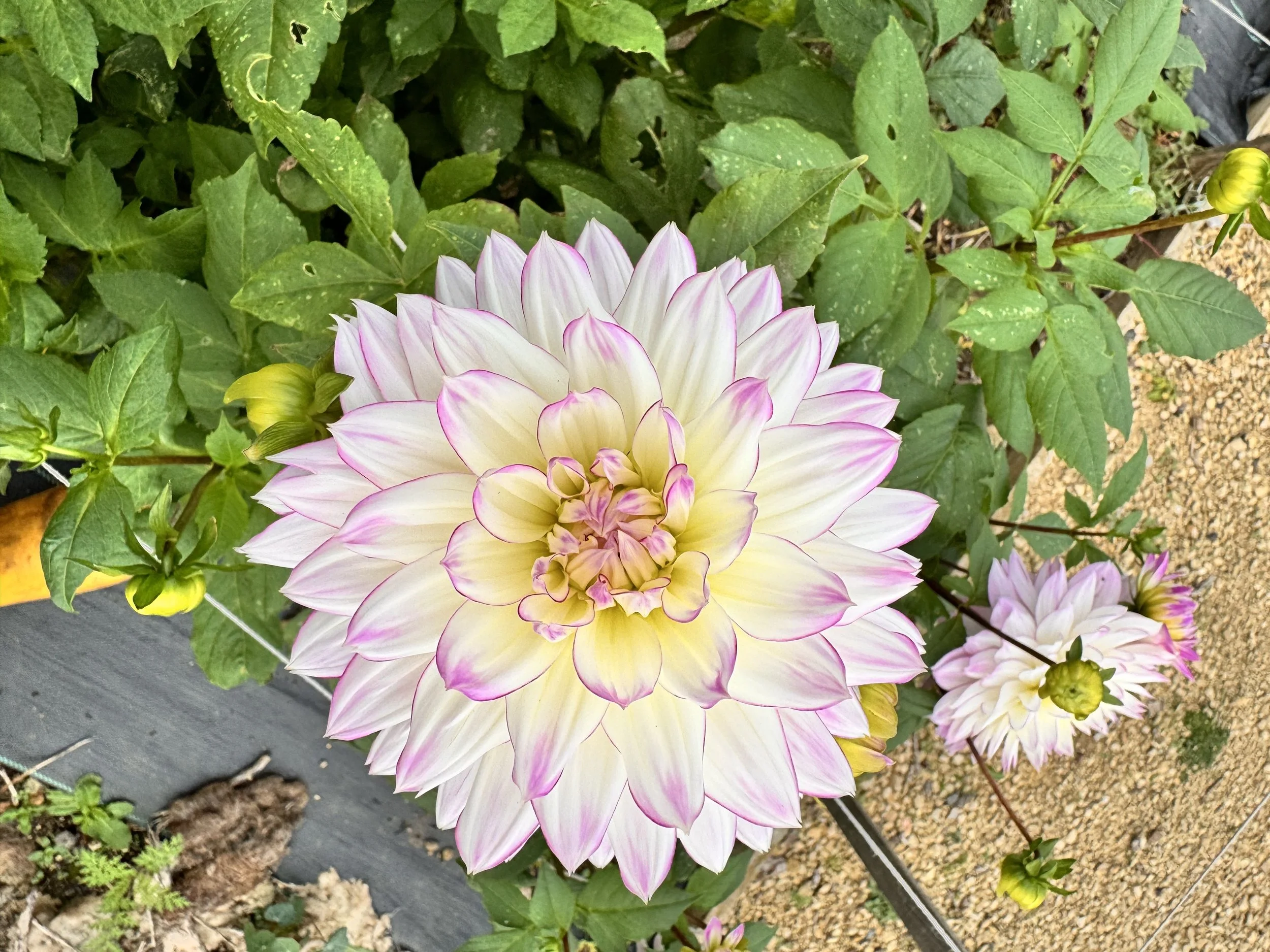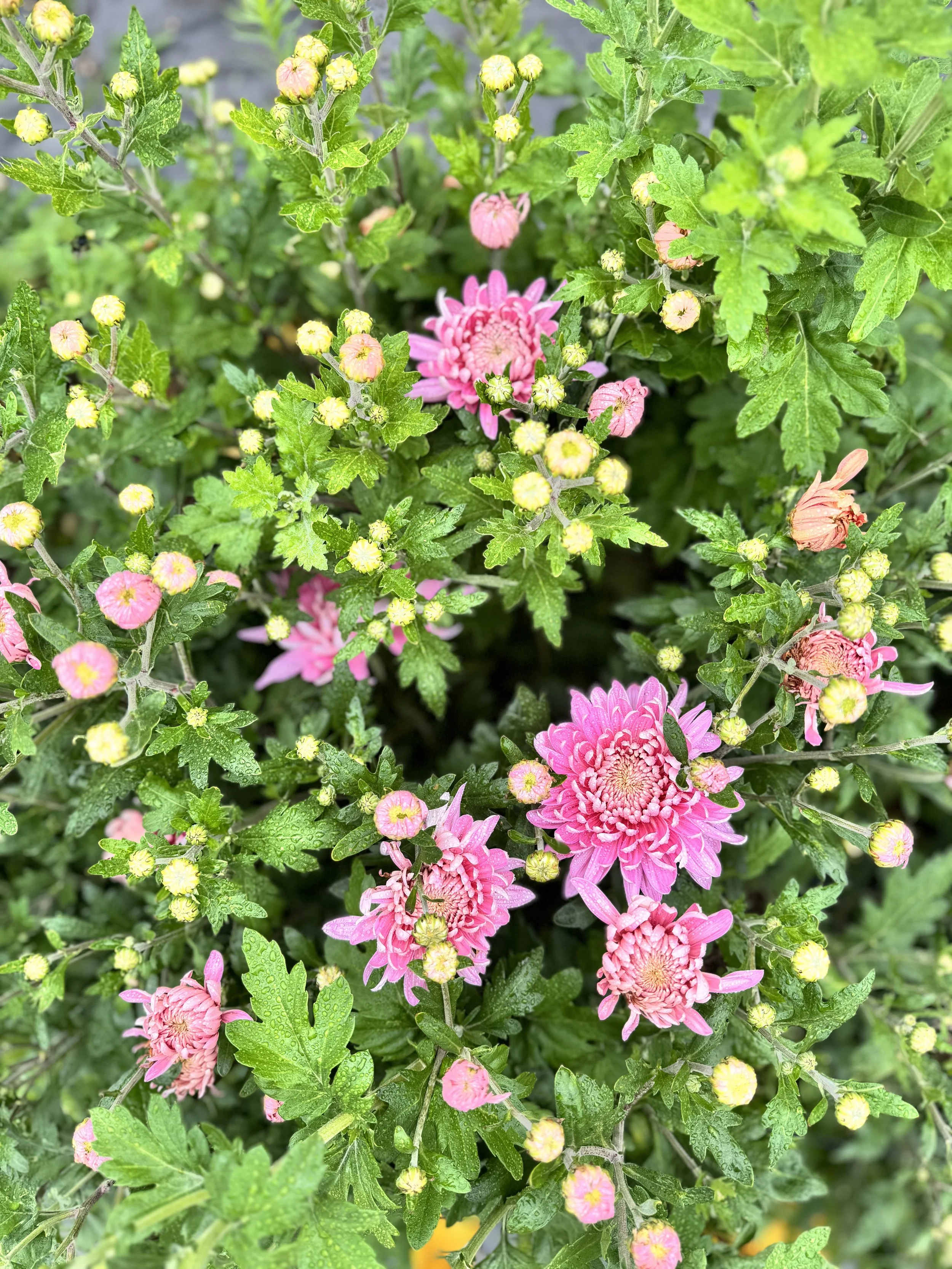Behind the Scenes After the Last Bouquet
When I sold my final bouquet of the season in early October, you’d think everything would suddenly go quiet. The last flowers cut, the buckets cleaned, the stand packed away. A neat little “The End” moment.
But the truth? This is when a whole different kind of work begins. It’s quieter, yes - but just as full, just as meaningful, and somehow even more reflective.
Putting the Flower Beds to Rest
After months of harvesting, deadheading, tying in, and coaxing along every stem, the beds finally get their winter rest. I start by gently clearing away the annuals that have given me everything they had - the cosmos, the dahlias, the zinnias - and tucking the soil back under a protective layer of compost.
There’s something strangely comforting in this stage. A kind of gratitude-filled goodbye to the plants that carried the whole season. And after the chaos of summer? The tidiness almost feels luxurious.
The Big End-of-Season Weed Out
One of the first (and least glamorous) jobs after the last bouquet is giving every single bed a proper, overdue weed. And let me tell you… some of them were wild this year. With so little time during the season, a few beds ended up with chunky tap roots, waist-high weeds, and seed pods just waiting to explode.
I pulled up so many weeds that I created a mountainous pile, which meant I then had to hunt down some wooden pallets and build myself an extra compost bay just to contain it all. The glamour of flower farming, right?
And of course - a few weeks later, all those weed seeds in the soil germinated, so I headed back out for a quick pass with the hoe to catch the tiny ones before they became another jungle. It’s a bit relentless, but that final, clean slate always feels so satisfying.
Mulching with Sheep’s Wool
Next up is mulching the beds that will sit empty over the winter. The very worst thing you can do is leave bare soil - the rain pounds it, washes it away, and turns the whole thing into a big soggy puddle. (Ask me how I know…)
So this year, I’ve been spreading sheep’s wool mulch over the beds I’m not planting until spring. It’s honestly one of my favourite mulches for winter. It creates a soft, protective layer that stops the soil from compacting in the rain and keeps all the good nutrients where they should be.
And sheep’s wool has so many perks:
• It slowly breaks down and feeds the soil.
• It holds onto water beautifully, releasing moisture back into the soil when needed.
• It suppresses weeds by forming a dense felt-like blanket.
• It’s completely natural, biodegradable, and sourced from British sheep.
• And it helps keep the soil temperature steadier - like tucking the beds in for their winter sleep.
It looks cosy, it works brilliantly, and it gives me huge peace of mind heading into the colder months.
Planting Bulbs in the Freshly Weed-Free Beds
Once the beds are finally cleared and mulched where needed, it’s time for one of my favourite autumn jobs: bulb planting. There’s something so hopeful about it - tucking little promises of spring into the soil just as everything else starts winding down.
The first boxes to arrive this year were camassia, Dutch iris, muscari, and - a new little experiment - garlic. I’ve squeezed the garlic between the campanula, and I’m really hoping it works. (There’s always one slightly questionable experiment happening on the plot!)
I’ve also been planting out the anemones and ranunculus that I pre-sprouted. They look tiny now, but I know they’ll be absolute stars when spring comes.
And a few perennials I grew from seed earlier in the year have finally found their forever homes - verbascum, aquilegia, and achillea. They’ve been waiting patiently in their pots, and it feels so satisfying to get them settled in the ground at last.
I’m still waiting for a few more plants to arrive - Dutch and Siberian iris, geum, lupins, and peonies - so once they turn up, I can get them planted out too. Fingers crossed they arrive soon!
My biennials were tucked in a few weeks ago and are looking absolutely splendid - strong little rosettes just waiting for spring to nudge them back into action.
It’s a quiet kind of thrill, filling the beds with the first signs of next year’s flowers.
Dahlias: Sorting, Checking, and Digging (Eventually)
And then there are the dahlias - always a whole job in themselves.
This is when I wander through the dahlia beds, combing through the plants and gently pulling up any that are showing signs of disease. It’s never fun, but it saves so much heartache later. Once they’re up, I label every single tuber with bright flagging tape because it is astonishingly easy to mix them up once they’re all in storage. (Ask me how I know…)
Every year I tell myself I’m going to save hours of digging, washing, drying, and storing by simply mulching them heavily and leaving them in the ground. And every year, I absolutely chicken out. My clay soil is just too risky - one cold, wet winter and I could lose the whole lot.
I also got them into the ground a little later than I’d hoped this year, so I’m leaving them in situ for as long as possible before I start digging. That… and I currently have a very long list of other jobs shouting for attention. The dahlias will get their turn soon. They always do.
Chrysanthemums: Sorting the Mix-Ups and Planning Ahead
The chrysanthemums also get their moment in the end-of-season shuffle. I’ve been going through each plant, giving them a good check, and - most importantly - labelling them properly this time. I took lots of cuttings last winter and, somewhere along the way, things got a bit… muddled.
So this year I’ve clearly labelled every single one to avoid another round of “mystery chrysanthemum roulette” next autumn.
Once everything was lined up and sorted, I realised something: I have loads of September/October flowering varieties, but not nearly enough of the October/November bloomers. Those late ones are absolute treasures - they carry me right to the edge of winter when everything else has finished - so I’m going to concentrate on building up my stock of those this year.
That means taking cuttings from just the late-flowering varieties and increasing my numbers properly, instead of accidentally cloning the early ones again. Lesson learned!
Taking Down Netting and Setting Up Low Tunnels
Another autumn job is dealing with the netting that protects some of the taller or more delicate flowers. This year, I carefully removed and wrapped up all the netting to use again next season. I source mine from Knowle Nets - it’s a heavy-duty knotted mesh rather than the moulded plastic type, so with a bit of care it should last me for years.
All my original wooden posts - the ones I’ve been using since the very first days of the front garden flower farm back in 2023 - have finally rotted through. I broke them into small pieces and added them to the compost. Time to add new posts to my shopping list for next year!
Once the netting and posts were dealt with, I also set up the low tunnels over my spring flowers. Most of these plants can cope with quite cold temperatures, so the tunnels aren’t about warmth as much as they are about protection from heavy rain and wind that could damage them over the winter. It’s a little bit of extra care now, but it pays off when the early blooms arrive next spring.
Inside Jobs: Planning, Sowing, and Paperwork
Not all post-season work happens outside - there’s a whole other world of “inside jobs” that keeps the flower farm ticking over during the quieter months.
I’ve been spending time on seed sowing for next year, getting a head start on early crops so they’re ready when spring arrives. Alongside this, I’m working out a seed sowing schedule - figuring out exactly when to start each variety to keep the blooms coming throughout the season.
It’s also the time for financial forecasting. Looking ahead to 2026, I’m reviewing last year’s costs, projecting what I’ll need to invest, and making sure there’s a plan for a sustainable, well-supported season.
I’ve been reaching out to brides and party clients for their 2026 events too, confirming details and helping them plan their bouquets well in advance. And of course, there’s flower subscriptions - lining up the first round of sign-ups and making sure the service is smooth from April onwards.
Finally, I’ve been giving the website a little spruce up. A bit of polish here and there, updating galleries, and making sure everything reflects the colours, flowers, and energy of the farm. It’s the quiet, detailed work that keeps the whole operation running smoothly - and, honestly, it’s quite satisfying to tick it all off.
Planning for 2026 Flower Subscriptions
And yes - this is the time of year when the big plans begin.
I’m now taking sign-ups for my 2026 flower subscriptions, ready for beautiful seasonal British flowers from April onwards.
This year, for the first time, I’ll also be offering delivery, which I’m ridiculously excited about. Every subscription purchased now helps me plan, order, sow, and grow with confidence through the winter.
Looking Ahead with Gratitude
Behind the scenes after the last bouquet isn’t glamorous - but it’s where next year’s magic begins.
It’s calm, thoughtful, occasionally muddy… and always full of possibility.
And I honestly love it just as much as the rush of summer.
Until next time,
Alicia - Cicely Flowers




